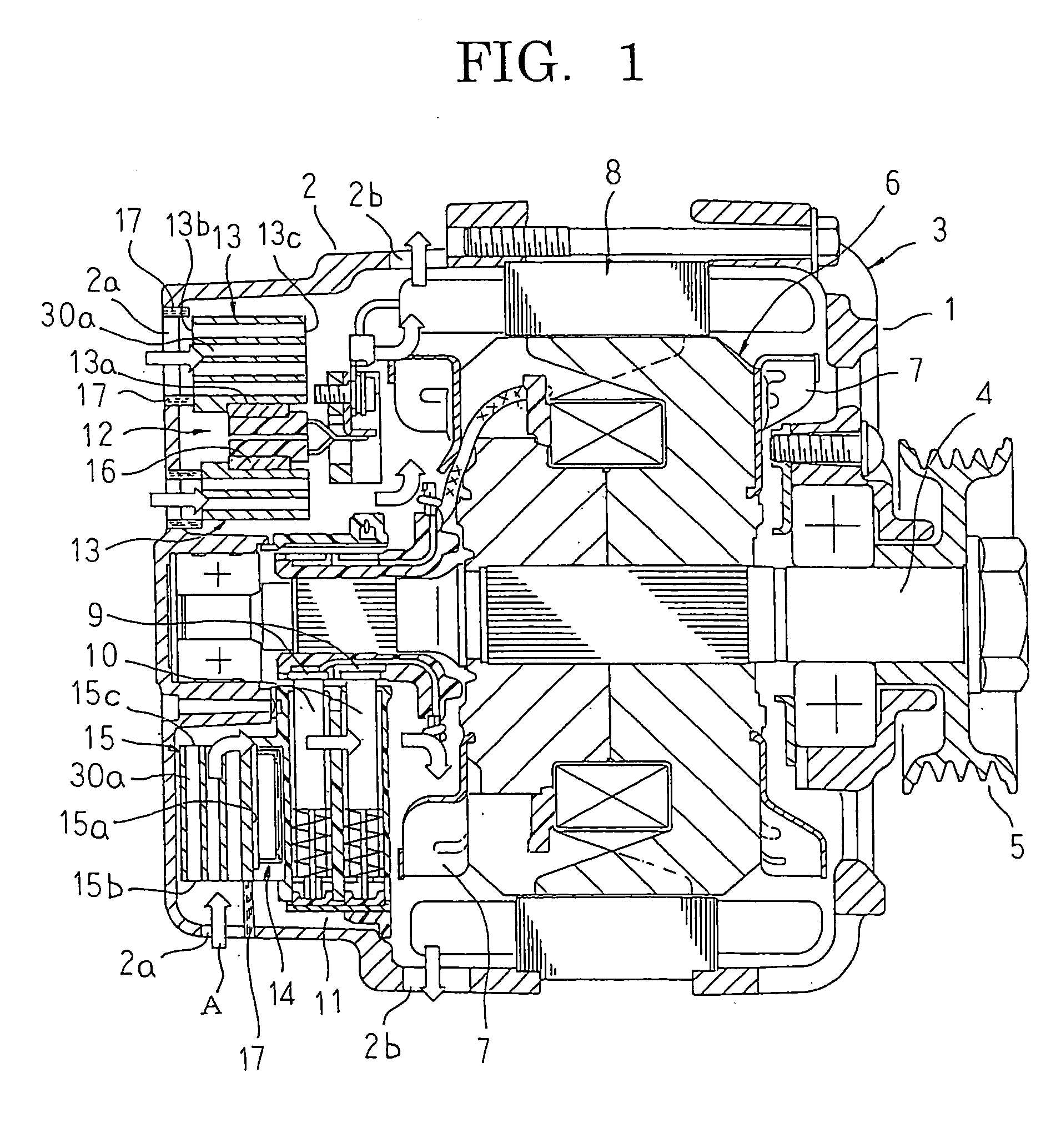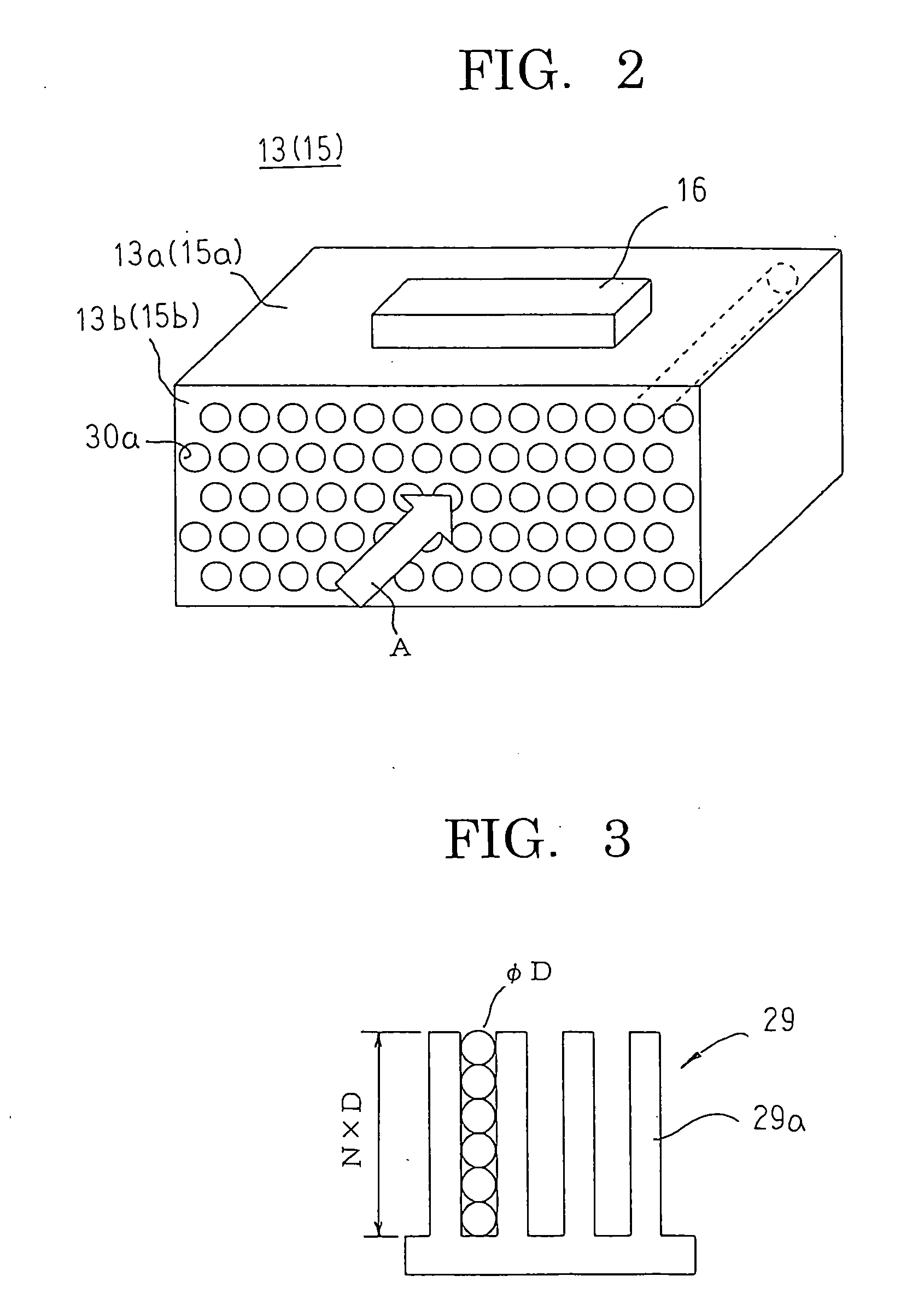Automotive dynamoelectric machine
- Summary
- Abstract
- Description
- Claims
- Application Information
AI Technical Summary
Benefits of technology
Problems solved by technology
Method used
Image
Examples
embodiment 1
[0024]FIG. 1 is a longitudinal section of an automotive alternator according to Embodiment 1 of the present invention, FIG. 2 is a perspective that explains a configuration of a heatsink in the automotive alternator according to Embodiment 1 of the present invention, and FIG. 3 is a diagram that explains heat radiating characteristics of the heatsink in the automotive alternator according to Embodiment 1 of the present invention. Moreover, in FIG. 1, arrows A represent cooling airflows.
[0025] In FIG. 1, an automotive alternator includes: a case 3 that is constituted by a front bracket 1 and a rear bracket 2 that are each approximately bowl-shaped and made of aluminum; a shaft 4 that is rotatably supported by the case 3; a pulley 5 that is fixed to an end portion of the shaft 4 that projects outward at a front end of the case 3; a rotor 6 that is fixed to the shaft 4 and accommodated inside the case 3; fans 7 that are fixed to two axial end surfaces of the rotor 6; a stator 8 that i...
embodiment 2
[0043]FIG. 4 is an end elevation of a heatsink in an automotive alternator according to Embodiment 2 of the present invention viewed from an apertured surface side.
[0044] In FIG. 4, semiconductor elements 16 are mounted to four surfaces, excluding an air intake apertured surface 13b and an air discharge apertured surface 13c, of a heatsink 13 that is formed into a rectangular parallelepiped.
[0045] Moreover, the rest of this embodiment is configured in a similar manner to Embodiment 1 above.
[0046] A large number of ventilating apertures 30a are formed so as to have aperture directions that are parallel to the element mount surfaces 13a and parallel to each other so as to pass through from an air intake apertured surface 13b to an air discharge apertured surface 13c that face each other on mutually opposite sides of the element mount surfaces 13a of the heatsink 13. These ventilating apertures 30a are arrayed in a staggered pattern within a cross section that is perpendicular to th...
embodiment 3
[0051]FIG. 5 is an end elevation of a heatsink in an automotive alternator according to Embodiment 3 of the present invention viewed from an apertured surface side.
[0052] In FIG. 5, a large number of ventilating apertures 30b that have a circular cross section are formed in a heatsink 13A so as to have aperture directions that are parallel to an element mount surface 13a and parallel to each other so as to pass through from an air intake apertured surface 13bto an air discharge apertured surface that face each other on mutually opposite sides of the element mount surface 13a. These ventilating apertures 30b are formed so as to have diameters that increase as distance from the element mount surface 13a increases. In addition, distances between adjacent ventilating apertures 30b are adjusted such that the percentage of area occupied by the ventilating apertures 30b in a cross section that is perpendicular to the aperture directions, i.e., the porosity, is constant over the entire sur...
PUM
 Login to View More
Login to View More Abstract
Description
Claims
Application Information
 Login to View More
Login to View More - R&D
- Intellectual Property
- Life Sciences
- Materials
- Tech Scout
- Unparalleled Data Quality
- Higher Quality Content
- 60% Fewer Hallucinations
Browse by: Latest US Patents, China's latest patents, Technical Efficacy Thesaurus, Application Domain, Technology Topic, Popular Technical Reports.
© 2025 PatSnap. All rights reserved.Legal|Privacy policy|Modern Slavery Act Transparency Statement|Sitemap|About US| Contact US: help@patsnap.com



